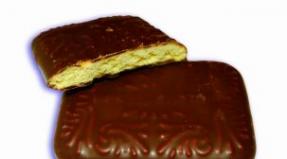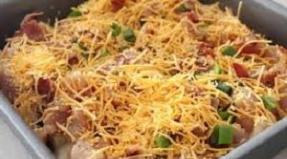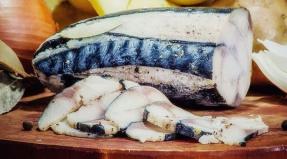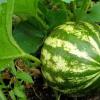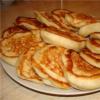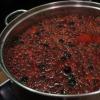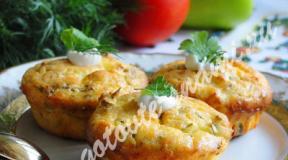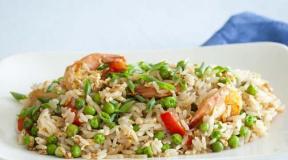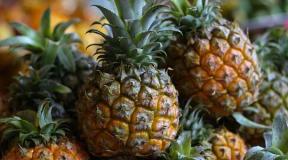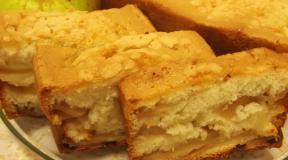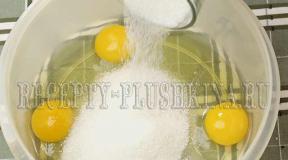Custard rings: a classic of the genre - a recipe with a photo. Back to the ussr: custard ring with curd cream - recipes
Custard ring with curd cream

Simple and delicious! Try it!
For the recipe you will need: (for 12-14 rings)
For the test:
125 g water
125 g milk
125 g butter
150 g flour
5 g salt
10 g sugar
4 - 5 large chicken eggs
For the cream:
100 g butter
150-200 g sugar
400 g soft cottage cheese
Sachet vanilla sugar(if desired)
Sugar for dusting rings
COOKING:
First, a little history choux pastry:
"It is believed that choux pastry invented in 1540 by Panterelli, the chef of Catherine de Medici, and named his work pate a Panterelli. Over the years, the original recipe changed, and with it the name: the dough was called pate a Popelini, later - pate a Popelin. Usually the "swaddling clothes" were shaped female breast- so, at least, it seemed to ardent Italians. Around 1760 French pastry chef Jean Avis (by the way, the teacher of the founder of the St. Petersburg culinary school Marie-Antoine Karem) created “shu” buns. True, something similar existed in French cuisine in the middle of the 18th century, but only similar, nothing more. Here is how pate a choux was prepared at that time: “Boil potatoes, mash. Add eggs and spoon into cabbage-like balls. Bake. "
The ingenious Jean Avis, undoubtedly familiar with the ideas of his predecessors (not without reason they say that French cuisine largely created by Florentine chefs), just replaced the potatoes with boiled flour and got fancy buns... Why buns? The fact is that Jean, about whom Karem wrote: "the famous Avis, master of choux pastry", at that time worked as the chief pastry chef in the best confectionery in Paris on rue Vivienne and delivered his masterpieces to the table of the great French diplomat Talleyrand. Subsequently, Karem himself had a hand in improving his teacher's choux pastry, which they began to call in the same way - pate a choux, that is, "dough for cabbage heads." Poor Panterelli and French mashed potatoes gone into oblivion. And the dough "shu" - "for cabbage heads" - on the contrary, went down in history. "
"Wikipedia" and nnm.ru/blogs/serein/pirozhnoe_shu
And now a little theory.
Water vapor is the driving force behind the choux pastry. Yes, yes, it is because of him that it rises so much during baking and it is thanks to the water vapor that a void is formed inside the cakes, which can be filled with filling or cream. In this regard, for a good rise, the choux pastry must, firstly, contain a large amount of water, and, secondly, it must be elastic enough to retain these vapors during the baking process. But first things first.
A high level of hydration of the choux pastry is achieved in two ways: by pre-brewing flour, as well as by introducing it into the dough a large number raw eggs which contain a lot of liquid in their composition. A few words about brewing: flour brewing consists of two stages - in the first stage, flour is poured into hot water, as a result of which the starch that is part of the flour gelatinizes and in such a gelatinized state it is able to retain much more water, which significantly increases the level of hydration of the dough, and at the second stage the dough is slightly dried, the liquid that remains unbound is evaporated.
So, by brewing and introducing raw eggs into the dough, the dough with a high level of hydration is kneaded, but this is not enough, because if the dough does not have sufficient elasticity, it will simply crack during baking and all the steam will run away without fulfilling its main purpose. In order for the dough to be elastic, firstly, it is very important to use flour with "strong" gluten or, at least, not to use flour with "weak" gluten, and secondly, pay special attention to the consistency of the dough so that it is not too liquid, nor too thick and, thirdly, pick up correct mode baking (taking into account the characteristics of your oven).
And now the recipe itself.
For choux pastry, heat water in a saucepan, add milk, chopped butter, salt, sugar. While stirring, make sure that the butter is completely dissolved, the salt and sugar are completely dissolved. Immediately after the start of the boil, remove the pan from the heat and in one fell swoop add all the flour required for the recipe (pre-sifted).

Rub the mixture vigorously with a spatula or spoon to achieve a uniform consistency (no flour lumps).
Return the saucepan to medium fire and with intensive rubbing - scrolling, warm up the dough for another 1 - 2 minutes until it gathers into a single lump and "begins to give off flour" i.e. until a white flour coating appears at the bottom of the pan.

Transfer the brewed dough to a bowl and grind for another 2 - 3 minutes, so that the dough cools slightly and stops being scalding hot (about 60 C).

Into the chilled dough gradually, one at a time, stir in chicken eggs.

Stir in eggs gradually, each subsequent one only after the previous one has completely intervened. If it is difficult to stir in a whole egg, you can first loosen the egg with a fork and stir in it in parts. Be sure to check the consistency of the dough before adding another egg. Ideally, it should slowly drain from the spatula in a triangle or, as they say, form a "bird's tongue".

Ready dough transfer to a pastry bag with a toothed or round nozzle (diameter about 10 mm) and place on a baking sheet lined with baking paper or lightly greased with vegetable oil or butter (when greasing with butter, be sure to dust it with flour). Place the rings at a distance of at least 4 - 5 cm from each other, since the dough greatly increases in volume during baking and slips may form when the deposition is close.


The baking mode for choux pastry is very dependent on the characteristics of your oven. Traditionally, baking begins in an oven preheated to 210-220 C, so that a light crust forms on the dough that prevents the release of water vapor, after 10 minutes the temperature is reduced to 180-190 C and already at this temperature they bake until golden brown and full readiness(about 25 more minutes).
It is very important not to open the oven door in the first 20 minutes, as this can lead to the dough settling, and it is just as important! bake the dough well, since unbaked bases can settle, and they will also be moist inside. Remember when baking Golden Rule that it is better to bake the choux pastry than not to bake it, so if in doubt it is ready - it is not ready, then it is better to decide that it is not ready and bake until there is no doubt.
In addition to the traditional one, there are other baking modes: you can bake bases at a constant temperature of 180 - 190 C; you can preheat the oven to 250 - 260 C, after planting the dough, turn off the oven completely, and after 10 - 15 minutes set it to 170 C and, at this temperature, the oven until cooked; or preheat the oven to 200 C, after 10 minutes set it to 170 C, and after another 10 minutes lower the temperature to 160 C and bake until fully cooked.
Only practice will show which mode will work in your oven, I prefer the most traditional, i.e. first option.
Immediately after baking, puncture the bases to release the remaining steam. I usually pierce with a tube that I will use to fill the rings. Punctures can be made from the bottom or from the side.

Transfer the baked rings to a wire rack and let cool completely.
Whisk the sugar and butter for the cream. Add a packet of vanilla sugar or a few drops of vanilla essence, if desired.
Stir in the curd and the cream is ready.

Transfer the cream to a piping bag with a narrow, long nozzle.
Fill the rings with cream.

A little icing sugar on top and enjoy your tea!
Ring with GOST curd cream

Custard ring loved by many. They often complain that at home the curd cream does not work out as it should.
In fact, everything is very simple and, in general, very typical for enterprises. Catering... For these rings, curd is mixed ... with butter cream. In half. In the simplest version, the cream is prepared from butter and powdered sugar, but more pleasant taste at the cream with the addition of condensed milk. It is with whipped butter cream that the filling turns out to be tender, not cloying and just right.
And I will not fail to say a few words about sugar and powdered sugar. Remember that sugar does not dissolve in butter. And if you put sugar in the cream, and not powder, it will crunch unpleasantly on your teeth. That is why powder is either added to the cream, or syrup is boiled from sugar (with milk and / or eggs). This also applies to vanilla sugar, if you use it - you need to grind it in a mortar before adding it to the cream.
Choux pastry is made according to this recipe, traditionally the rings are deposited through a toothed nozzle, then powdered sugar is very beautifully laid on them. The diameter of the nozzle is 10-15 mm.
Ingredients for 15 pieces
200 g flour
100 g butter
180 g water
a pinch of salt 2 g
300 g eggs (5 large)
320 g cottage cheese
17 5g butter
90 g icing sugar
65 g condensed milk
1 bag of vanilla sugar
1 tbsp cognac or dessert wine
Powdered sugar for dusting
Preparation:
So, for the dough, put 100 g of butter in a saucepan, pour 180 g of water, put a pinch of salt. Bring to a boil.

Add sifted flour (200g) and mix well.

The flour should be brewed and the dough should clump together.
Attention! The flour should be well-cooked; for this, do not remove it from the heat immediately, but stir it right on the stove.

Transfer it to a bowl to cool to at least 60C.

Swirl the eggs in a bowl.

Add little by little, kneading the dough with a mixer or spatula.


Ready dough.

Transfer to a bag with a serrated tip with a diameter of 10-15mm, place the rings on a baking sheet lined with baking paper.

Bake at 220C for 15 minutes, then at 180C for 25 minutes. Cool down.

Prepare the cream.
Beat the softened butter with powdered sugar and crushed vanilla sugar until whitening. Add condensed milk in several portions, whisk thoroughly at maximum speed. Add cognac at the end.

Rub the cottage cheese through a sieve into the finished cream.


Cut the rings and fill them with cream. You can from a bag, you can just use a spoon.

Sprinkle with powder.

But before you eat - cool it down!

Custard Custard Recipe

Delicate curd sweetness combined with air test: what could be more beautiful for nutritious breakfast or treats at a family tea party?
Ingredients:
For the test
Water - 125 g
milk - 125 g
butter - 125 g
wheat flour - 150 g
egg - 5 pcs.
sugar - 10 g
salt - 5 g
For cream
Butter - 100 g
cottage cheese - 400 g
sugar - 150 g
powdered sugar
Cooking method:
1.To prepare the dough, heat the water in a saucepan, pour in milk, butter, add salt and sugar. Cook, stirring constantly, until the butter is completely dissolved and the salt and sugar dissolve. As soon as the mixture boils, remove the pan from the heat and add the sifted flour.
2. Stir the dough with a silicone spatula until smooth. We return the pan to the stove and do not stop heating over medium heat and rubbing with a spatula until the dough begins to gather into a single mass.
3. Transfer the dough to a bowl and grind until it cools slightly.
4.B warm dough stir in chicken eggs one by one. The dough should become elastic and drain slowly from the shoulder blade. If the dough does not drain, stir in another egg.
5. We put the oven to preheat to 200 degrees. We transfer the dough into a pastry bag with a toothed nozzle and plant the rings on a baking sheet (at a distance from each other, as they will increase in size), covered with parchment paper... To prevent the paper from slipping, put a few drops of water on the baking sheet and only then lay the paper down.
6. We bake the rings at 200-220 degrees for about 10 minutes, then lower the temperature to 180 degrees and cook for another 20-30 minutes. The door cannot be opened during the baking process, and if the rings are not baked, they can then settle.
7. Put the finished rings on the grate and make punctures in them for steam to escape, through the same punctures we will later fill them with cream.
8. Prepare the cream. Beat butter at room temperature with sugar and cottage cheese. It is best to use curd soft, homogeneous.
9. Put the cream in a pastry bag with a long nozzle and fill the cooled rings with it. Before serving, sprinkle them with powdered sugar (it is more convenient to do this through a sieve). Bon Appetit!
Ring with curd cream

The most real GOST custard ring. It is done quickly enough, it is eaten even faster.
Dough: about 15 pieces
Water - 180 g
Butter - 100 g
Flour - 200 g
Egg (large) - 5 pcs or 300 g
A pinch of salt
Preparation:
Bring water, salt and oil to a boil. Add flour immediately, mix quickly and thoroughly without removing from the stove. The flour should be well brewed, no white lumps should remain. Stir the dough on the stove until it begins to lag behind the walls of the dish and gathers into a lump. Allow to cool to a temperature of 60 * C (so that the eggs are not brewed). Gradually adding eggs, knead the dough with a mixer, spatula or just a whisk. Put the finished dough on parchment in the form of rings. Bake at T = 220 * C for the first 10 minutes, then at T = 180 * until tender (about 25 minutes). Cool down.
Cream:
Butter - 150 g
Cottage cheese - 200 g
Powdered sugar - 90 g
Condensed milk - 65 g
Vanillin/ vanilla sugar
Preparation:
Beat butter with powder and vanilla until fluffy. Continuing to beat, add condensed milk. Rub the cottage cheese through a sieve (if with lumps), put in butter cream and beat again.
Cut the rings lengthwise and fill with cream. Sprinkle with icing sugar on top.
It is not at all necessary to make rings, you can plant round shu. In the original, there was a little more butter and less cottage cheese. I rounded. It is better to cool the finished cakes first, then sprinkle with powder, because cream
melts quickly due to the large amount of oil.
Custard cakes " Curd ring"

Custard cakes with delicate curd cream. Favorite cakes of our childhood.
Products
For choux pastry:
125 ml water
125 ml milk
100 g creamy margarine or oil
150 g flour
4 eggs
a pinch of salt
For curd cream:
300 g cottage cheese
50 g butter
120 g sugar
1 bag of vanilla sugar
icing sugar for decoration
How to make curd ring custard cakes:
1. Let's prepare the choux pastry. Bring margarine (or butter), milk, water and salt to a boil over low heat until the margarine is completely dissolved.
2. Add the sifted flour and mix thoroughly. Knead the dough over the fire for at least two minutes. The dough should clump together and fall well behind the sides of the pan.
3. Remove from heat and let the dough cool slightly (up to 60 degrees). Add eggs one at a time while kneading the dough.
4. Transfer the thoroughly kneaded dough into a pastry sleeve (pastry bag, syringe) with a serrated attachment, and squeeze the rings (15 pieces) onto a baking sheet covered with parchment.
5. Send the dough into an oven preheated to 210 degrees and bake the cakes for 10-15 minutes. Then reduce the temperature to 180 degrees and bake until tender for another 15-20 minutes. Pierce the finished custard cakes with a toothpick to release the air. Cool it down.
6. Prepare curd cream for custard cakes. Whisk butter with sugar and vanilla sugar.
7. Rub the curd through a sieve and add to the butter. Whisk the cream until smooth.
8. Cut the cooled cakes and fill with cream. Sprinkle the cottage cheese rings with powdered sugar.
Custard cakes "Curd ring" are ready. Bon Appetit!
Custard rings with curd cream

Ingredients 6 servings
Wheat flour 200 g
Chicken egg 3 pieces
Water 180 g
A pinch of salt
Cottage cheese 320 g
Butter 175 g
Condensed milk 65 g
Vanilla sugar to taste
Cognac 1 tablespoon
Icing sugar 1 tablespoon
Instructions
1. To prepare choux pastry, pour water into a saucepan, add oil and salt. Put on fire. When the mixture boils and the butter has completely melted, add the sifted flour at once. Stir thoroughly and quickly, on the heat, until all the flour is well done. Transfer the finished dough to a bowl so that it cools down to 60-70 degrees (or lower).
2. Meanwhile, loosen the eggs in a separate bowl. Add eggs to the dough little by little, stirring each time until smooth. The finished dough has a homogeneous structure, a viscous consistency, falls off the spoon if it hits the edge of the bowl.
3. Transfer the dough to a toothed pastry bag (diameter 10-15 mm) and place 15 rings on a baking sheet (average diameter 65 mm). Bake for 15 minutes at 210 degrees, then 25-30 minutes at 180 degrees. Refrigerate.
4. For the cream, beat the butter with icing sugar and vanilla sugar until fluffy and light color, add a little condensed milk, whisking well. Add the cognac at the end of the whisk. Rub the curd through a sieve and add to the cream. Mix thoroughly.
5. Cut the rings and fill with cream. Sprinkle with powdered sugar and chill well.
After a few days off, I did a morning run through the garden plots. Please do not be confused, not a raid, but a run :-)
It was raining at night. The grass is wet, fresh, good. It smells like a new harvest and close autumn. And at home he is waiting hot tea and air custard rings, which he baked yesterday until late at night.
After taking a shower, I looked into the children’s room and saw a picture: the smaller child, lying in bed, hugging a plate, tramples these same cakes and smiles with his lips stained with cream ...
Custard Custard Recipe
For the test:
- flour - 200 g;
- butter - 100 g;
- water - 180 g;
- eggs - 5 pieces;
- a pinch of salt;
For the cream:
- cottage cheese - 320 g;
- butter - 175 g;
- icing sugar - 90 g;
- condensed milk (regular, not boiled) - 65 g;
- a bag of vanilla sugar (10 g);
- a tablespoon of brandy;
- some powdered sugar for dusting.
I have wanted to do it for a long time, and now, I decided.
When I was cooking, I said that I was not going to buy electronic scales. And now I measured the products on the scales, so as not to make a mistake and get the dough of the desired consistency.
He took a saucepan, put oil in it, poured water.

He threw in another pinch of salt, put it on the fire and brought it to a boil. To get choux pastry, you need to make the fire smaller, without removing the saucepan from the stove, sift flour into it.

I just didn’t have time to cook and take pictures, so I put the pan on the table so that the dough would not burn. I quickly mix the contents with a spatula, and when the dough sticks together, becomes homogeneous and shiny, I remove it from the stove.

Put it in a bowl and chill until warm. V separate dishes smashed the eggs, beat them a little with a whisk.

Add the eggs to the dough in portions of a few spoons and stir with a mixer.


It turns out this is such a viscous dough.

I load it into a 10 mm toothed piping bag. I put the custard rings about 6-7 cm in diameter on a baking sheet with parchment paper.


I'll clarify right away that the first cakes turned out to be not very lush, so then I planted the rings in two layers - what was needed came out. Or you should use a larger nozzle, 15 mm in diameter, but I don't have one.
In general, the pastry bag is a separate story, the two Chinese versions of the bag and syringe that I had earlier tortured to death with their inconvenience.
The whole city went until he found in a completely inconspicuous shop a normal bag with simple and reliable stainless steel attachments. It costs twice as much, but, as they say, we are not rich enough to buy cheap things ...
According to the recipe, cakes should be baked for the first 15 minutes - at a temperature of 220 degrees, then 25 minutes - at 180 degrees. It took me about 30 minutes for everything (especially the oven). It turned out two dozen cakes.

For the cream, I ground vanilla sugar in a mortar to a powdery state, because the sugar grains do not dissolve in oil, and will crunch on my teeth. For the same reasons, instead of regular sugar powder is also taken for the cream.

Beat well softened butter with a mixer with powdered sugar and vanilla sugar.

I add condensed milk in portions and continue to beat at high speeds for several minutes.

In conclusion, add cognac and beat a little more. I rub the cottage cheese straight into the cream through a fine sieve.


I also decided to add a summer flavor to half of the cream. Mixed it with a few spoons of thawed homemade strawberries- delicious food!

I cut the cooled rings with a knife and stuff them with cream (you can just use a spoon).

Sprinkled with powder. The beauty!

And it would be necessary to try, but I have already tried condensed milk, and cream, and strawberries. Nevertheless, I ate a small ring - wonderful and awesome!

The next morning the custard rings were even tastier - they were infused. It is necessary to do it, especially since almost half of the cream remains, keep this in mind. I also want to cook with glaze ...
That's all for today. Good luck and see you soon, dear readers!
Many of us just love childhood custard custards, and I'm no exception to the rule =). I tried several recipes for filling for rings: and with curd mass from the store, and with sugar, and with white chocolate - everything is delicious, but "everything is not right" tastes. The cottage cheese cream that I will talk about in this recipe turned out to be ideal. In fact, it is very simple to prepare and its secret is that the cottage cheese is mixed with butter cream, this is the only way to get a homogeneous, smooth, very tasty and delicate filling for custard rings.
Ingredients for choux pastry (15 rings):
- Flour - 200 g
- Butter - 100 g
- Water - 180 g
- Salt - 1/3 tsp
- Eggs - 300 g without shell (this is about 4-5 large C0 eggs)

Ingredients for curd cream:
- Cottage cheese - 320 g
- Butter - 175 g
- Powdered sugar - 90 g
- Condensed milk with sugar - 65 g
- Vanilla sugar - 10 g
- Cognac or dessert wine- 1 tbsp.

How to make choux pastry for cakes (step by step recipe with photo):
If you have ever cooked according to my recipes, then you can easily cope with the rings, because any choux pastry from the above recipes is suitable for making them.
Put butter (100 g) in a deep-bottomed saucepan, pour out water (180 g), add salt (1/3 tsp), put on fire and melt. The fire should be medium so that everything melts and heats up as quickly as possible.

Stir the contents of the saucepan constantly so that the mixture melts and boils faster.

Before boiling, the fire can be high or medium, but after boiling, it should be reduced to low.

Wait for the mixture to boil and immediately add all the flour (200 g).

Stir until the lumps disappear so that the white flour is nowhere to be seen. We make intense movements, trying to smooth the dough along the sides and bottom of the stewpan. This will work at first, but as you brew, the dough will clump together.

The dough will be brewed correctly if it has stood on the fire for 2 minutes after gluing into a ball, and a film appears at the bottom of the stewpan. The photo below shows that there is a crust at the bottom. It should not be torn off (otherwise it will be felt in the finished cakes as hard lumps), the very fact of such a layer at the bottom suggests that everything is going according to plan. Set the choux pastry aside and go to the eggs.

Eggs (300 g) must be stirred with a fork until the whites and yolks are combined. The egg mass should be added gradually, in small portions, because the dough may be too runny if you accidentally transfer the eggs. 
Pour eggs into the dough (about 1/5 part), stir. Then pour the same portion, stir again, and so on. When very little egg mass remains in the bowl with eggs, carefully monitor the thickness of the dough. You may not need the last batch of eggs.

This photo shows how thick the dough should be, flowing from the spatula into the bowl, it forms a "triangle"

Transfer the dough to a pastry bag (you can use the star attachment or another attachment with cloves). Squeeze out the dough in a circle in the form of a ring, leaving a void in the middle. In this way, proceed with the entire dough, leaving a distance of 2-3 centimeters between the workpieces (the choux dough rises and swells up in the oven, increases in size).
I bake all products on Teflon mats, you can also use silicone mats, baking paper, whatever you like and trust.

Preheat the oven for baking cakes to a temperature of 200 C, "Top-Bottom" mode. Bake the first 10 minutes at 200 C, then lower the temperature to 170 C and bake for another 20 minutes (depending on the power of your oven, it may take a little more or less time) The finished cakes should be a beautiful ruddy color, absolutely dense crust (when tapping a dull empty sound should be emitted on the surface).
It is very important not to open the oven for the first 20 minutes of cooking! Otherwise, the dough will settle and won't rise again!

Cooking curd cream for cakes
In the very simple recipe the cream is made from butter and powdered sugar, but if you add condensed milk, the cream will be even tastier. It is the whipped butter cream that is responsible in the filling for tenderness, uniformity, in addition, the curd cream ceases to be sugary sweet.
Many people replace icing sugar with regular sugar... It should be remembered that sugar cannot dissolve in butter. If you make such a replacement, it will feel in the cream and crunch on your teeth. It is for this reason that either powder is added to the cream, or sugar syrup with milk and eggs is cooked (as in).
For curd cream, you need to choose a pasty curd. If you use a grainy one, it will be very difficult to bring it to a uniform state. Initially, you need to beat the softened butter (175 g) with powdered sugar (90 g) until white.

It is not recommended to replace powdered sugar with regular sugar, because even the smallest sugar dissolves in oil with great difficulty, it will feel like grains in the cream. It is also better to take powdered sugar without additives in the form of starch. It is for this reason that it is recommended to use vanilla extract rather than vanilla sugar. If you decide to add vanilla sugar, rub it with a pestle and a mortar.

Beat the cream until smooth.

Pour in condensed milk (65 g). I only use high quality condensed milk without vegetable fats in the composition (manufacturer - "Rogachev") .. There are often cases that only 2 tablespoons of bad condensed milk spoil the whole cream: it begins to exfoliate, is taken in flakes, other troubles arise. Most likely, the reason lies in condensed milk: modern part manufacturers add solid vegetable fats type palm oil into their products.

As for the cottage cheese for the cream, as I said above, homogeneous, pasty cottage cheese in briquettes is ideal, which can be additionally rubbed through a metal sieve directly into the cream (320 g).

Beat the cream again for 1-2 minutes until smooth.

The finished curd cream looks smooth and uniform.
Filling the custard rings with cream
After the custard rings have cooled, cut each into two halves. The porous structure on the inside indicates that the dough was brewed correctly.

Transfer the cream to a pastry bag (you don't have to use a metal nozzle here), squeeze the filling into each ring in a circle and cover with the second part of the ring.

These are the custard rings with cottage cheese cream. Enjoy your tea!

When adding a photo to Instagram, please indicate the tag #pirogeevo or #pirogeevo, so that I can find your photos on the network and rejoice with you. Thanks!
In contact with
Recipe custard rings with curd cream:
Prepare the custard dough. To do this, combine butter, water, salt and sugar in a saucepan.

Put a saucepan on fire and bring the contents to a boil over medium heat until the butter is completely melted.

Pour all the flour into the boiled mixture in one fell swoop. Be sure to sift the flour first so that there are no lumps in it, otherwise it will be difficult to get rid of them during brewing.

Without removing the saucepan from the heat, brew the dough for 1-2 minutes, while actively stirring the dough, it should gather into a smooth and dense ball. Remove the saucepan with the dough from the heat and let it cool slightly. To cool the dough faster, you can beat it with a mixer with dough attachments for a few minutes.

Add eggs to the cooled dough, one at a time. Next egg add only after the previous one is completely mixed into the dough. To make the kneading process less laborious, you can use a mixer with dough hooks at this stage.

The finished choux pastry should be very light, smooth and shiny.

Put the choux dough for rings into a pastry bag with a wide (10-15 mm) round or serrated nozzle, and if there is no special bag, then use a regular tight bag.

Line a baking sheet with baking paper. Using a bag, squeeze out the dough into rings of the desired diameter. Leave large gaps between the custard rings, as they will grow 2-3 times in volume during baking.

Bake the custard rings in an oven preheated to 200 C for 15 minutes, then lower the temperature to 170 and bake them for another 25-30 minutes. Do not open the oven for the first 30 minutes of baking, as the cakes may fall off. Finished custard rings should dry well on the inside and golden on the outside beautifully. Let the rings cool completely.

Make curd cream. In a bowl, combine butter, icing sugar and vanilla sugar.

Beat it at the maximum speed of the mixer until a fluffy and light cream is obtained.

Without stopping whisking, pour condensed milk into the butter cream in small portions.

In the resulting butter cream, rub the cottage cheese through a sieve.

And beat again thoroughly until you get a homogeneous curd cream.

Cut the cooled custard rings into 2 halves, as shown in the photo.

Put the cream in a pastry bag with a round nozzle and use it to apply the curd cream to the bottom of the custard ring.

Cover the cream with the other half of the ring.

That's all! The custard rings are ready.

Cool the rings well before serving and, if desired, sprinkle with powdered sugar.

If nothing like this happened in your childhood, we still recommend you this quick and win-win perfect dessert.
Custard rings are especially great for breakfast with fragrant tea or tart strong coffee.
WELDED RING RECIPE
What do you need:
Dough:
500 ml water
1 pinch of salt
120 g margarine
280 g flour
6-8 eggs (6 large)
powdered sugar - for decoration
Cream:
700 ml cream 38%
6 tbsp icing sugar
vanillin - on the tip of a knife
How to make custard rings:
1. For the test, heat the oven to 170 ° C.
2. Pour water into a saucepan, put on fire. Add a pinch of salt.
3. Cut the margarine into cubes and add to the saucepan.
4. Heat until margarine is completely melted. Never bring to a boil.
5. Remove the saucepan from the heat and add all the flour at once. Mix thoroughly and vigorously.
6. Return the saucepan to the fire and heat for 2-3 minutes, stirring constantly, until the dough easily falls behind the sides and bottom of the saucepan. Remove from heat. Refrigerate.
7. Transfer the dough to the mixer bowl and gradually introduce the eggs one at a time, each time actively beating the mass until smooth.
8. Transfer the dough to a pastry bag with the "cloves" attachment and place the rings on a baking sheet lined with baking paper.

If pastry bag and there is no attachment, you can use an ordinary plastic bag by cutting off the corner.
9. Bake rings until golden brown for 15-20 minutes. Cool the cakes completely on the wire shelf at room temperature... Using a sharp knife, cut each ring into 2 equal parts.
10. For the cream, beat the cooled cream until soft peaks.

11. Sift the icing sugar and vanillin into the cream.
12. Beat first at the minimum speed of the mixer until the icing sugar and cream are completely mixed, then increase the speed and beat until firm foam.
Read also ...
- Recipes for making coffee with ice cream at home
- Strawberry panna cotta - a classic of world culinary What is panna cotta with strawberries
- Cream of curd cheese for cake - the best recipes for impregnating and decorating dessert
- Profiterole recipe and three original custard recipes Protein cream for profiteroles
